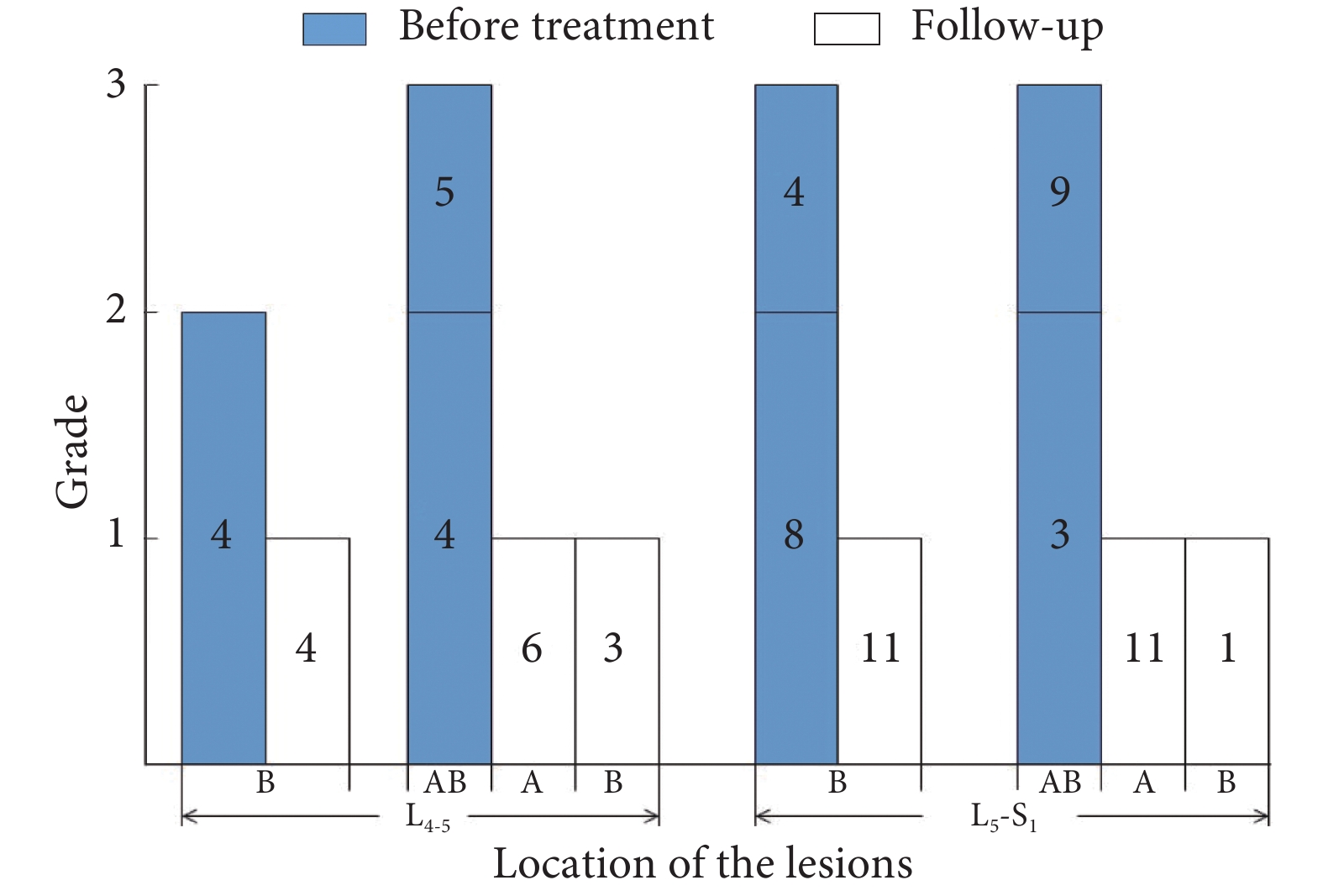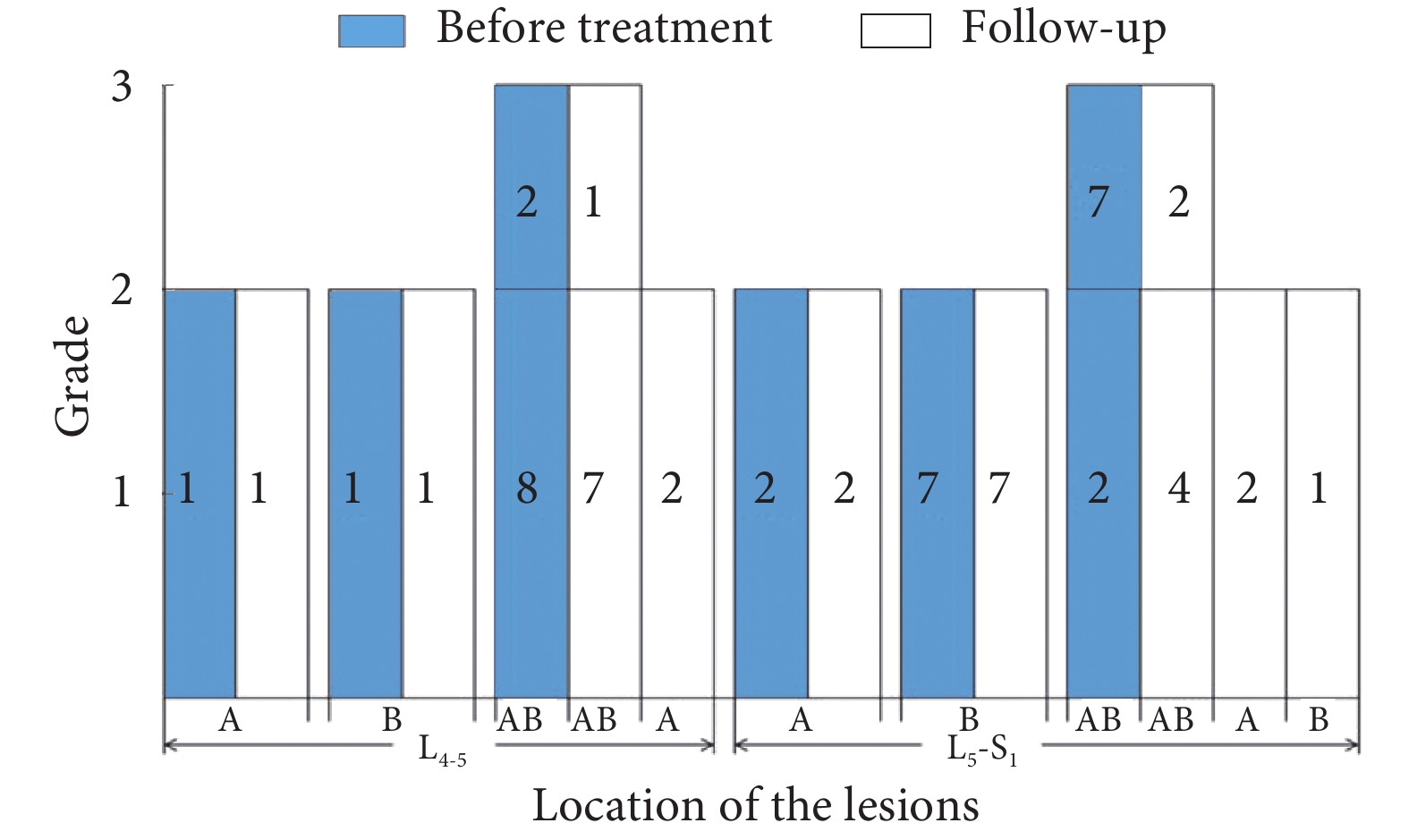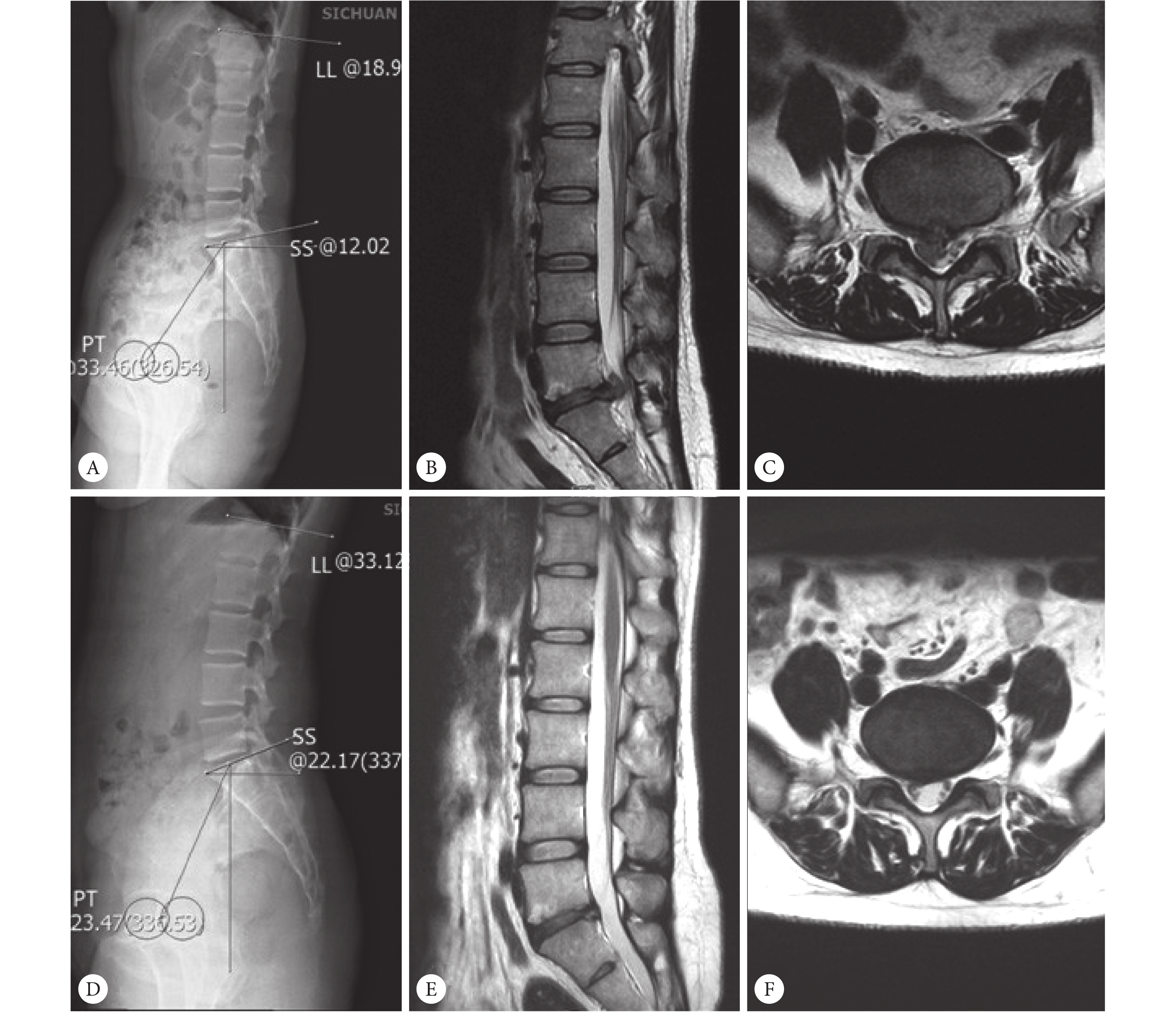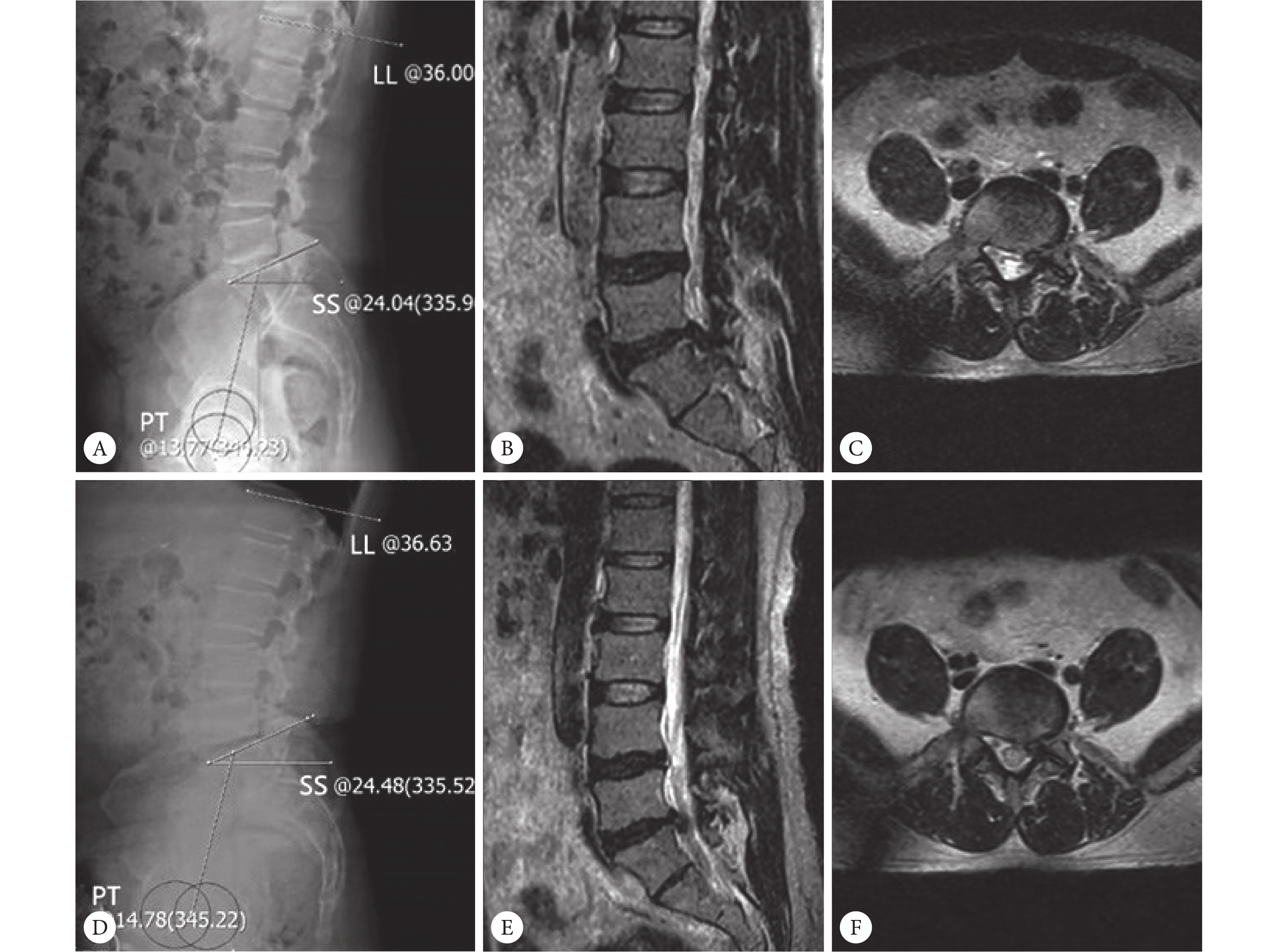Sagittal Balance Parameters Correlate with Resorption of the Lumbar Disc Extrusion: Results of a Retrospective Study
-
摘要:目的 研究腰椎间盘脱出以及脱出重吸收后腰椎-骨盆矢状面参数相应的改变。方法 收集2010年5月−2019年3月按北美脊柱协会(NASS)推荐的诊断标准、诊断为腰椎间盘脱出患者的资料,依据随访时影像检查显示的脱出椎间盘吸收程度,将患者分为吸收组〔突出椎间盘完全消失,或残留的椎间盘局限在按美国密歇根州立大学(Michgan State University,MSU)学者提出的影像学分型的1级之内〕和未吸收组(脱出间盘未发生变化,或虽有缩小但突出仍超过1级),站立位照片确定骨盆-脊柱参数〔包括骨盆入射角(PI)、骨盆倾斜角(PT)、骶骨倾斜角(SS)和腰椎前凸角(LL)〕,通过多因素方差分析比较两组前后各参数之间的变化。结果 共计67例腰椎间盘脱出症患者纳入本研究,患者症状都得到了满意的缓解。其中吸收组37例,平均年龄42.6岁,男21例,女16例,腰4~5椎间盘脱出13例,腰5骶1椎间盘脱出24例,平均随访 22个月;未吸收组30例,平均年龄40.8岁,男19例,女11例,其中腰4~5椎间盘脱出12例,腰5骶1椎间盘脱出18例,平均随访21个月。两组比较,年龄、性别、吸烟史、慢性病史、突出节段、MSU分型、随访时间等基线情况差异均无统计学意义(P>0.05)。在随访结束时,吸收组矢状面30例移位全部消失,突出间盘从初始的MSU分型2级19例、3级18例变为吸收后残留间盘全部局限在1级以内;未吸收组矢状面移位从20例减少到14例,突出间盘从初始的MSU分型2级21例、3级9例变为2级27例,3级3例。治疗前两组比较,各脊柱-骨盆参数(PI、SS、PT、LL)差异均无统计学意义(P>0.05);治疗后(随访结束时)比较,两组PI差异无统计学意义(P>0.05),吸收组SS、LL均值大于未吸收组,PT均值小于未吸收组,差异有统计学意义(P<0.05)。组内比较,吸收组治疗前后PI、SS、PT差异无统计学意义(P>0.05),LL治疗后变大,差异有统计学意义(P<0.05);未吸收组治疗前后脊柱-骨盆各参数差异均无统计学意义(P>0.05)。结论 间盘脱出重吸收后导致脊柱-骨盆参数发生相应的变化,反之,脊柱-骨盆参数的改变表明腰椎能更好地缓冲负荷,减轻间盘压力,从而导致间盘重吸收的发生。Abstract:Objective A retrospective study was designed to explore the relationship between the satittal spinopelvic alignment in patients with lumbar disc extrusion and spontaneous resorption.Methods From May 2010 to March 2019, referring to NASS evidence-based clinical guidelines, patients with lumbar disc extrusion were enrolled in this retrospective study, according to the degree of herniation size during the follow-up, the patients were divided into two groups: resorption (group R: the herniated disc completely disappeared or the herniation size was grade 1 according to Michgan State University (MSU) classification) and nonresorption (group N: the herniated disc remain unchanged or the herniation size overpass grade 1), spinopelvic parameters (including the pelvic incidence (PI), sacral slope (SS), pelvic tilt (PT), lumbar lordosis (LL)) were determined on standing profile radiographs of the lumbar spine and pelvis, and mean values were compared using the multi-factor analysis of variance.Results This study included 67 patients with lumbar disc extrusion. There were 37 in group R (the average age was 42.6 years), 21 males and 16 females, 13 cases at L4-5 level and 24 cases at L5-S1 level, follow-up 22 months, and 30 in group N (the average age was 40.8 years), 19 males and 11 females, 12 cases at L4-5 level and 18 cases at L5-S1 level, follow-up 21 months, at the follow up time, there symptoms were all satisfactorily relieved. There were no signifcant differences in age, gender, smoking history, chronic medical history, prominent segmnet, MSU classification, follow up time and other baseline conditions between two groups (P>0.05). At the follow-up, in group R, all 30 cases of sagittal displaced disc disappeared, the herniated disc changed from the initial MSU classification of grade 2 in 19 cases and grade 3 in 18 cases to the post-absorption residual disc, which were limited to grade 1; in group N, 20 cases of sagittal displaced disc reduced to 14 cases, the herniated disc changed from the initial MSU classification of grade 2 in 21 cases and grade 3 in 9 cases to grade 2 in 27 cases and grade 3 in 3 cases. There was no significant difference in spinopelvic parameters between the two groups before the treatment (P>0.05). At the follow-up, there was no significant difference in PI between the two groups (P>0.05); the SS and LL in group R were bigger than those in group N, the PT in group R was smaller than that in group N, and the difference was statistically significant (P<0.05). Compared within the same group, before treatment and follow-up, there were no significant differences in PI, SS and PT in group R, but a bigger LL (P<0.05); no significant differences in all the parameters in group N were found.Conclusion Resorption may result in pinopelvic parameter changes, which suggest that the lumbar spine is better at cushioning against load, reducing the disc pressure, and leading to resorption of the herniated disc.
-
椎间盘突出自发性吸收或重吸收是指在无化学消融和外科干预的情况下,突出的椎间盘自发消失或变小的情况。研究表明,已有多种机制被证实在椎间盘重吸收的过程中起作用,主要包括血管化[1],后纵韧带撕裂后突出髓核接触到硬膜外腔血供[2],各种炎症介质、神经递质介导的以吞噬细胞为主的降解反应[3]、脱水[4]以及细胞凋亡等[5]。从我们既往的经验看,腰椎间盘突出症尽管突出物巨大,患者症状重,但只要没有马尾综合征或进行性神经根麻痹,都可以进行非手术治疗,随着突出间盘的缩小,预后良好[6]。从突出类型来看,椎间盘脱出发生重吸收的概率最高,突出物体积越大或游离距离越大越容易发生重吸收[7]。但此类突出又恰巧是手术治疗的极佳适应症,因此如何做到合理的治疗选择是临床需要思考的问题。
从脊柱矢状面平衡来看,间盘突出伴随脊柱-骨盆参数的改变早已被证实[8]。那么脊柱矢状面重塑对运动单位应该会有一个良好的应力分配效应,但突出间盘自然吸收之后其矢状面排列会发生什么样的改变,到目前为止未见有相关报道,本研究正是对此进行了初步观察,结果报道如下。
1. 对象与方法
1.1 研究对象
选取2010年5月−2019年3月我院收治的腰椎间盘突出、且具有完整影像资料的患者,所有患者均通过详细询问病史、体格检查、影像学检查以获得明确诊断。影像学检查包括:站立位脊柱正侧位X光片(包括胸12~股骨头),腰椎MRI和/或CT平扫。病例纳入标准:①年龄:18~60岁;②按北美脊柱协会(NASS)推荐诊疗指南[9],满足腰椎间盘脱出的影像学描述,并有与之相吻合的临床征象;③非手术治疗有效,包括适当的卧床休息、物理治疗、非甾体类消炎镇痛药、推拿、针灸、生活方式的修正及适宜的身体训练等,所有治疗均按我院标准操作规范进行;④随访时症状缓解,满足正常生活所需。排除标准:①肿瘤、骨质疏松、创伤、各种滑脱、狭窄、感染、侧凸等畸形;②神经肌肉性、代谢性、风湿免疫性疾病;③超过一个节段的突出;④既往脊柱手术史。
1.2 影像学测量
应用picture-archiving and communication system(PACS)对以下脊柱-骨盆矢状面参数进行测量:①骨盆入射角(pelvic incidence ,PI):经S1 上终板中点作该终板的垂线,该垂线和S1上终板的中点与股骨头中心连线的夹角;若双侧股骨头不重叠,取两股骨头中心连线的中点作为中心点。②骶骨倾斜角(sacral slope,SS):S1上终板和水平线的夹角。③骨盆倾斜角(pelvic tilting,PT):S1 终板中点和股骨头中心连线与垂直线的夹角。若双侧股骨头不重叠,取两股骨头中心连线的中点作为中心点。④腰椎前凸角( lumbar lordosis,LL):S1 上终板和L1上终板椎体终板线向后延长线的夹角。⑤突出间盘位置与容积的判定:矢状面按NASS推荐诊疗指南[9],突出间盘离开间盘层面,进入头侧和尾侧椎管者称为移位,包括椎弓根上区、椎弓根区和椎弓根下区;横断面按美国密歇根州立大学(Michgan State University,MSU)学者提出的影像学分型,将突出分为1-A到3-AB共10个亚型[10]。1~3级是指突出间盘在横截面上的程度分级,1级最小,3级最大;A、B、AB是指突出间盘所在部位,A相当于中央区,B相当于旁中央区,AB相当于中央区加旁中央区。
1.3 随访
所有患者在首次就诊治疗后5个月开始进行随访检查,若超过一次随访,则以最后一次随访为截至时间,内容包括症状、体格检查、影像学检查等,方法与基线调查相同;最终随访时间截至2019年3月31日。
1.4 分组
依据随访时影像检查显示的突出吸收程度,将病例分为吸收组(突出间盘完全消失,或残留间盘局限在MSU 1级之内)和未吸收组(突出间盘未发生变化,或虽有缩小但突出仍超过MSU 1级)。
1.5 统计学方法
计量资料采用成组设计t检验,计数资料采用卡方检验;采用多因素方差分析,比较两组治疗前后及两组之间PI、SS、PT、LL等脊柱-骨盆参数的差异,P<0.05为差异有统计学意义。
2. 结果
2.1 两组患者基本信息比较
共计67例符合要求的腰椎间盘突出症患者纳入本回顾性研究,男40例,女27例,年龄24~60岁,平均41.8岁,随访5~93个月(平均随访时间为21个月),见表1。两组间年龄、性别、吸烟史、慢性病史、突出节段、MSU分型、随访时间等基线情况,差异均无统计学意义(P>0.05)。
表 1 研究对象基本信息表Table 1. Basic information sheet of patientsCharacteristic Total
(n=67)Resorption
group (n=37)Non-resorption
group (n=30)Age/yr., $\bar x \pm s$ 42.43±8.99 43.14±9.32 41.57±8.59 Gender/case (%) Male 40 (59.70) 21 (31.34) 19 (28.36) Female 27 (40.30) 16 (23.88) 11 (16.42) Smoke/case (%) Yes 14 (20.90) 10 (14.93) 4 (5.97) No 53 (79.10) 27 (40.30) 26 (38.81) Diabetes/case (%) Yes 2 (2.99) 0 (0) 2 (2.99) No 65 (97.01) 37 (55.22) 28 (41.79) Segment/case (%) L4-5 25 (37.31) 13 (19.40) 12 (17.91) L5-S1 42 (62.69) 24 (35.82) 18 (26.87) Displaced disc/case (%) Yes 50 (74.62) 30 (44.78) 20 (29.85) No 17 (25.38) 7 (10.45) 10 (14.93) MSU cassification/case (%) Grade 2 40 (59.70) 19 (28.36) 21 (31.34) Grade 3 27 (40.30) 18 (26.87) 9 (13.43) Follow up/month, $ \bar x \pm s $ 21.41±18.20 21.55±17.22 21.24±19.63 MSU: Michgan State University 2.2 两组患者的MSU分型及转归情况
在随访结束时,吸收组30例矢状面移位全部消失,突出间盘从初始的MSU分型2级19例、3级18例变为吸收后残留间盘全部局限在1级以内;未吸收组矢状面移位从20例减少到14例,突出间盘从初始的MSU分型2级21例,3级9例变为2级27例,3级3例(图1、图2)。
2.3 两组患者脊柱-骨盆参数的比较
吸收组病例治疗前后PI、SS、PT差异无统计学意义(P>0.05),LL治疗后变大,差异有统计学意义(P<0.05);未吸收组病例治疗前后脊柱-骨盆各参数差异均无统计学意义(P>0.05)。
治疗前两组病例比较各脊柱-骨盆参数(PI、SS、PT、LL)差异均无统计学意义(P>0.05);随访时比较,两组病例PI差异无统计学意义(P>0.05),吸收组SS、LL均值大于未吸收组,PT均值小于未吸收组,差异有统计学意义(P<0.05)。见表2、图3、图4。
表 2 治疗前和随访时两组患者脊柱-骨盆矢状面参数比较Table 2. Comparison of sagittal spinopelvic parameters between patients with resorption and non-resorption before the treatment and during the follow-upIndex Time Resorption group (n=37) Non-resorption group (n=30) P△ PI/° Before treatment 42.65±6.00 41.83±5.52 0.563 Follow-up 43.42±6.24 41.84±6.23 0.306 P* 0.592 0.994 – SS/° Before treatment 27.89±8.31 27.68±6.50 0.907 Follow-up 31.16±6.56 26.19±7.06 0.004 P* 0.065 0.399 – PT/° Before treatment 14.76±7.51 14.15±5.13 0.706 Follow-up 12.26±6.48 15.65±6.57 0.038 P* 0.130 0.329 – LL/° Before treatment 37.06±14.72 36.77±9.10 0.924 Follow-up 45.34±11.09 33.69±9.54 0.000 P* 0.008 0.205 – * P value for the comparison of before treatment vs. follow-up; △P value for the comparison between two groups; PI: Pelvic incidence; SS: Sacral slope; PT: Pelvic tilting; LL: Lumbar lordosis ![]() 图 3 吸收组1例33岁女性患者。入院时的脊柱-骨盆矢状面形态(A)、矢状面MRI(B)如图示,横截面MSU分型为3-AB(C )。7个月后复查时脊柱-骨盆矢状面形态,LL、SS变大,PT变小(D),MRI显示L5S1脱出间盘已吸收(E),MSU分型为1-A(F)Figure 3. A 33 years old female patient in resorption group. Sagittal spinopelvic alignment (A) and sagittal images of MRI (B) were shown; MSU classification was 3-AB before the treatment (C). Sagittal spinopelvic alignment at the follow-up after 7 months, LL and SS increased while PT decreased (D); the herniated disc had been resorbed in MRI (E); MSU classification was 1-A (F)
图 3 吸收组1例33岁女性患者。入院时的脊柱-骨盆矢状面形态(A)、矢状面MRI(B)如图示,横截面MSU分型为3-AB(C )。7个月后复查时脊柱-骨盆矢状面形态,LL、SS变大,PT变小(D),MRI显示L5S1脱出间盘已吸收(E),MSU分型为1-A(F)Figure 3. A 33 years old female patient in resorption group. Sagittal spinopelvic alignment (A) and sagittal images of MRI (B) were shown; MSU classification was 3-AB before the treatment (C). Sagittal spinopelvic alignment at the follow-up after 7 months, LL and SS increased while PT decreased (D); the herniated disc had been resorbed in MRI (E); MSU classification was 1-A (F)![]() 图 4 非吸收组1例46岁男性患者。入院时脊柱-骨盆矢状面形态(A)、矢状面MRI(B)如图示,横截面MSU 分型为2-B(C)。14个月后复查时脊柱-骨盆矢状面形态,LL、SS、PT均未见明显改变(D);MRI显示L5S1脱出椎间盘未发生显著变化(E);MSU分型仍然为2-B(F)Figure 4. A 46 years old male patient in non-resorption group. Sagittal spinopelvic alignment (A) and sagittal images of MRI (B) were shown; MSU classification was 2-B before the treatment (C). Sagittal spinopelvic alignment at the follow-up after 7 months, no significant changes were observed among the parameters (D); MRI showed that the herniated disc had not changed (E); MSU classification was still 2-B (F)
图 4 非吸收组1例46岁男性患者。入院时脊柱-骨盆矢状面形态(A)、矢状面MRI(B)如图示,横截面MSU 分型为2-B(C)。14个月后复查时脊柱-骨盆矢状面形态,LL、SS、PT均未见明显改变(D);MRI显示L5S1脱出椎间盘未发生显著变化(E);MSU分型仍然为2-B(F)Figure 4. A 46 years old male patient in non-resorption group. Sagittal spinopelvic alignment (A) and sagittal images of MRI (B) were shown; MSU classification was 2-B before the treatment (C). Sagittal spinopelvic alignment at the follow-up after 7 months, no significant changes were observed among the parameters (D); MRI showed that the herniated disc had not changed (E); MSU classification was still 2-B (F)3. 讨论
3.1 脊柱-骨盆参数在正常人群增龄及退行性疾病中的变化趋势
脊柱-骨盆参数决定了椎间盘受力的性质、方向和在三关节复合体中分担力的比例,以及脊柱和骨盆的关系。在正常人群中,男女间矢状面参数没有明显差异[11],在所有腰椎矢状面参数中,只有PI与体位无关,不随人体体位改变,是个体特征性的腰椎矢状面参数[12],即便年龄增加至60岁以上,PI也不会有明显变化[13-14]。在直立体位,人体通过腰椎前凸来适应骶骨向前的倾斜,如果PI加大,为保持平衡,LL也会随之越大,下腰段承受的剪切应力增加,压应力减小;反之,PI减小,LL亦减小,下腰段承受的剪切应力减小,压应力增加。随年龄增加,LL和SS减小而PT增大,特别是超过70岁后变化更加明显[14-15]。RAJNICS等[16]分析了50例腰椎间盘突出症患者和30例无症状志愿者的X片,发现腰椎间盘突出者LL和SS均较小,认为是更加直立的脊柱形态加大了腰椎压应力,加速了腰椎间盘退变,是发生腰椎间盘突出的重要因素。MARDARE等[17]回顾性研究了腰椎间盘突出症的患者,手术组和非手术组之间的脊柱-骨盆参数差异无统计学意义,但都表现出比正常人群更小的PI、LL、SS和更大的PT。FEI等[8]分析了100例35以下年轻腰椎间盘突出患者及与之对应的正常人群,发现两组之间PI无明显差别,腰椎间盘突出患者具有更小的LL、SS和更大的PT。以上研究都显示脊柱-骨盆参数和腰椎间盘突出之间存在着直接的相关性,尽管脊柱-骨盆参数有增龄性改变,但LL、SS越小,PT越大,则脊柱在矢状面越接近垂直,脊柱前柱所承受的压力负荷越大,椎间盘承受的压力越大,发生椎间盘退变和突出的可能性也就越大,发病年龄也大大提前。
椎间盘突出症发病阶段患者会通过骨盆后移、脊柱前屈甚至侧凸的方式缓解症状,甚至部分患者呈现一种强迫体位,SS减小和PT的增大意味着骨盆围绕着股骨头向后旋转和髋关节的后伸,导致骨盆向后移动,以及与之伴随的腰椎前凸消失,这被认为是骨盆代偿腰椎退变性疾病的一个重要步骤[18],即脊柱-骨盆参数的改变既是间盘突出的危险因素,间盘突出同时又引起脊柱-骨盆参数的改变,两者中哪个是启动因素至今仍无有效方法区分,但出现后二者容易导致恶性循环。
3.2 吸收组和未吸收组的筛选
在症状、体征、影像学吻合的情况下,间盘突出的容积是治疗选择的一个重要条件,手术医师往往愿意选择“巨大”突出的患者进行手术[10]。临床也证实突出超过矢径1/3、神经根有受压及移位的患者能得到更好的手术效果[19]。CARRAGEE等[20]报道相比于大突出患者术后良好的效果及较低的复发率(3.5%),小突出患者术后效果不佳及很高的复发率(40%)。那么对MSU分型1级以下者直接排除在手术治疗之外也就顺理成章。因此,间盘突出吸收后残余间盘在MSU分型1级以下者,被本研究默认为“理想”吸收。
3.3 治疗手段对脊柱-骨盆参数的影响
ENDO等[21]比较了61例腰椎间盘突出者术前和术后的矢状面参数,发现术后LL和PT有一定恢复,认为这种改变源于人体的疼痛保护机制,以及椎间盘退变引起的椎间隙高度丢失。LIANG等[22]也发现随着突出间盘的切除,LL、SS立即缩小同时PT变大,但他选择的是25例矢状面失平衡的腰椎间盘突出症患者,那么疼痛保护姿态随疼痛的解除而缓解。
本研究表明,尽管症状在随访时都得到了良好的缓解,但未吸收组所有的参数前后并没有明显差异,这说明除了部分强迫体位外,绝大多数的腰椎间盘突出症患者脊柱-骨盆参数的变化并非一个急性时相反应,疼痛的改善也不会直接修正脊柱-骨盆参数。
从吸收组来看,伴随突出间盘的吸收,脊柱-骨盆参数也发生了相应的变化,PI作为个体特征性的腰椎矢状面参数不会因为突出吸收与否而发生改变,与未吸收组相比,SS和LL变大的同时PT变小,这导致腰椎生理曲度的加大,脊柱前柱所承受的压力负荷减小,病损椎间盘承受的压应力也随之减小,骨盆对腰椎间盘突出的代偿机制取消,避免了进一步向失平衡方向恶化,突出间盘在压力减小的环境中可能激发了自我消融机制,我们已知的自身免疫、血管化、炎性、脱水、细胞凋亡等机制在合适应力的条件下可能更易发挥其作用,从而表现出突出吸收现象,这对患者来说无疑是一个福音。这提示我们可以采取某种方式改变脊柱-骨盆参数来帮助突出间盘的重吸收;对于固定的PI,LL和SS呈正相关,直接增加LL的方式是不可行的,那么就可以设法增加SS来加大LL,从而让生理曲度得到改善。另一个方面,随着突出间盘的吸收,椎间隙都有不同程度的降低[23],这说明突出髓核诱导的重吸收反应不仅仅发生于突出部分,在盘内也会出现同样的吸收反应,椎间隙高度的降低导致了运动单位所受应力的再分配,从而修改了脊柱-骨盆参数。
未吸收组在随访时无明显临床症状,但腰椎退行性疾病复发率较高,在其复发时必然面临手术的选择。另外这两组中哪组容易复发,还需进一步的观察与研究。
受诸多因素影响,本研究纳入的病例偏少,单纯采用PI等指标使得结果偏粗糙。Roussouly分型[24-25]指出在不同的脊柱-骨盆参数的情况下,运动单位的受力模式、代偿方式及退变类型是不同的,那么相似类型的退变在不同类型的应力环境下,其转归应会不同,因此下一步我们拟增加观察例数,并引入Roussouly分型全脊柱指标,分析在不同分组情况下同一类型突出间盘的自然转归,为治疗选择的优化提供参考意见。
间盘脱出重吸收后导致脊柱-骨盆参数发生相应的变化,反之,脊柱-骨盆参数的改变表明腰椎能更好地缓冲负荷,减轻间盘压力,从而导致间盘重吸收的发生,脊柱矢状面平衡重塑在突出间盘重吸收中起着重要的作用,这提示我们可以采取某种方式改变脊柱-骨盆参数以利于脱出间盘重吸收。
-
图 3 吸收组1例33岁女性患者。入院时的脊柱-骨盆矢状面形态(A)、矢状面MRI(B)如图示,横截面MSU分型为3-AB(C )。7个月后复查时脊柱-骨盆矢状面形态,LL、SS变大,PT变小(D),MRI显示L5S1脱出间盘已吸收(E),MSU分型为1-A(F)
Figure 3. A 33 years old female patient in resorption group. Sagittal spinopelvic alignment (A) and sagittal images of MRI (B) were shown; MSU classification was 3-AB before the treatment (C). Sagittal spinopelvic alignment at the follow-up after 7 months, LL and SS increased while PT decreased (D); the herniated disc had been resorbed in MRI (E); MSU classification was 1-A (F)
图 4 非吸收组1例46岁男性患者。入院时脊柱-骨盆矢状面形态(A)、矢状面MRI(B)如图示,横截面MSU 分型为2-B(C)。14个月后复查时脊柱-骨盆矢状面形态,LL、SS、PT均未见明显改变(D);MRI显示L5S1脱出椎间盘未发生显著变化(E);MSU分型仍然为2-B(F)
Figure 4. A 46 years old male patient in non-resorption group. Sagittal spinopelvic alignment (A) and sagittal images of MRI (B) were shown; MSU classification was 2-B before the treatment (C). Sagittal spinopelvic alignment at the follow-up after 7 months, no significant changes were observed among the parameters (D); MRI showed that the herniated disc had not changed (E); MSU classification was still 2-B (F)
表 1 研究对象基本信息表
Table 1 Basic information sheet of patients
Characteristic Total
(n=67)Resorption
group (n=37)Non-resorption
group (n=30)Age/yr., $\bar x \pm s$ 42.43±8.99 43.14±9.32 41.57±8.59 Gender/case (%) Male 40 (59.70) 21 (31.34) 19 (28.36) Female 27 (40.30) 16 (23.88) 11 (16.42) Smoke/case (%) Yes 14 (20.90) 10 (14.93) 4 (5.97) No 53 (79.10) 27 (40.30) 26 (38.81) Diabetes/case (%) Yes 2 (2.99) 0 (0) 2 (2.99) No 65 (97.01) 37 (55.22) 28 (41.79) Segment/case (%) L4-5 25 (37.31) 13 (19.40) 12 (17.91) L5-S1 42 (62.69) 24 (35.82) 18 (26.87) Displaced disc/case (%) Yes 50 (74.62) 30 (44.78) 20 (29.85) No 17 (25.38) 7 (10.45) 10 (14.93) MSU cassification/case (%) Grade 2 40 (59.70) 19 (28.36) 21 (31.34) Grade 3 27 (40.30) 18 (26.87) 9 (13.43) Follow up/month, $ \bar x \pm s $ 21.41±18.20 21.55±17.22 21.24±19.63 MSU: Michgan State University 表 2 治疗前和随访时两组患者脊柱-骨盆矢状面参数比较
Table 2 Comparison of sagittal spinopelvic parameters between patients with resorption and non-resorption before the treatment and during the follow-up
Index Time Resorption group (n=37) Non-resorption group (n=30) P△ PI/° Before treatment 42.65±6.00 41.83±5.52 0.563 Follow-up 43.42±6.24 41.84±6.23 0.306 P* 0.592 0.994 – SS/° Before treatment 27.89±8.31 27.68±6.50 0.907 Follow-up 31.16±6.56 26.19±7.06 0.004 P* 0.065 0.399 – PT/° Before treatment 14.76±7.51 14.15±5.13 0.706 Follow-up 12.26±6.48 15.65±6.57 0.038 P* 0.130 0.329 – LL/° Before treatment 37.06±14.72 36.77±9.10 0.924 Follow-up 45.34±11.09 33.69±9.54 0.000 P* 0.008 0.205 – * P value for the comparison of before treatment vs. follow-up; △P value for the comparison between two groups; PI: Pelvic incidence; SS: Sacral slope; PT: Pelvic tilting; LL: Lumbar lordosis -
[1] AUTIO R A, KARPPINEN J, NIINIMAKI J, et al. Determinants of spontaneous resorption of intervertebral disc herniations. Spine,2006,31(11): 1247–1252. DOI: 10.1097/01.brs.0000217681.83524.4a
[2] AHN S H, AHN M W, BYUN W M. Effect of the transligamentous extension of lumbar disc herniations on their regression and the clinical outcome of sciatica. Spine,2000,25(4): 475–480. DOI: 10.1097/00007632-200002150-00014
[3] LE MAITRE C L, FREEMONT A J, HOYLAND J A. Localization of degradative enzymes and their inhibitors in the degenerate human intervertebral disc. J Pathol,2004,204(1): 47–54. DOI: 10.1002/path.1608
[4] HENMI T, SAIRYO K, NAKANO S, et al. Natural history of extruded lumbar intervertebral disc herniation. J Med Invest,2002,49(1/2): 40–43.
[5] HA K Y, KIM B G, KIM K W, et al. Apoptosis in the sequestrated nucleus pulposus compared to the remaining nucleus pulposus in the same patient. Spine,2011,36(9): 683–689. DOI: 10.1097/BRS.0b013e3181da0286
[6] 戴国钢, 刘剑伟, 楚福明, 等. 突出椎间盘自然吸收现象的回顾性研究. 临床骨科杂志,2014,17(6): 617–621. DOI: 10.3969/j.issn.1008-0287.2014.06.001 [7] RYU S J, KIM I S. Spontaneous regression of a large lumbar disc extrusion. J Korean Neurosurg Soc,2010,48(3): 285–287. DOI: 10.3340/jkns.2010.48.3.285
[8] FEI H, LI W S, SUN Z R, et al. Analysis of spino-pelvic sagittal alignment in young Chinese patients with lumbar disc herniation. Orthop Surg,2017,9(3): 271–276. DOI: 10.1111/os.12340
[9] FARDON D F, WILLIAMS A L, DOHRING E J, et al. Lumbar disc nomenclature: version 2.0: recommendations of the combined task forces of the North American Spine Society, the American Society of Spine Radiology and the American Society of Neuroradiology. Spine J,2014,14(11): 2525–2545. DOI: 10.1016/j.spinee.2014.04.022
[10] MYSLIWIEC L W, CHOLEWICKI J, WINKELPLECK M D, et al. MSU classification for herniated lumbar discs on MRI: toward developing objective criteria for surgical selection. Eur Spine J,2010,19(7): 1087–1093. DOI: 10.1007/s00586-009-1274-4
[11] JANSSEN M M, DREVELLE X, HUMBERT L, et al. Differences in male and female spino-pelvic alignment in asymptomatic young adults: a three-dimensional analysis using upright low-dose digital biplanar X-rays. Spine,2009,34(23): E826–E832. DOI: 10.1097/BRS.0b013e3181a9fd85
[12] MAC-THIONG J M, LABELLE H, BERTHONNAUD E, et al. Sagittal spinopelvic balance in normal children and adolescents. Eur Spine J,2007,16(2): 227–234. DOI: 10.1007/s00586-005-0013-8
[13] YEH K T, LEE R P, CHEN I H, et al. Are there age- and sex-related differences in spinal sagittal alignment and balance among Taiwanese asymptomatic adults? Clin Orthop Relat Res,2018,476(5): 1010–1017. DOI: 10.1007/s11999.0000000000000140
[14] SOHN S, CHUNG C K, KIM Y J, et al. Sagittal spinal alignment in asymptomatic patients over 30 years old in the Korean population. Acta Neurochir (Wien),2017,159(6): 1119–1128. DOI: 10.1007/s00701-017-3100-9
[15] YUKAWA Y, KATO F, SUDA K, et al. Normative data for parameters of sagittal spinal alignment in healthy subjects: an analysis of gender specific differences and changes with aging in 626 asymptomatic individuals. Eur Spine J,2018,27(2): 426–432. DOI: 10.1007/s00586-016-4807-7
[16] RAJNICS P, TEMPLIER A, SKALLI W, et al. The importance of spinopelvic parameters in patients with lumbar disc lesions. Int Orthop,2002,26(2): 104–108. DOI: 10.1007/s00264-001-0317-1
[17] MARDARE M, OPREA M, POPA I, et al. Sagittal balance parameters correlate with spinal conformational type and MRI changes in lumbar degenerative disc disease: results of a retrospective study. Eur J Orthop Surg Traumatol,2016,26(7): 735–743. DOI: 10.1007/s00590-016-1842-3
[18] BARREY C, ROUSSOULY P, PERRIN G, et al. Sagittal balance disorders in severe degenerative spine. Can we identify the compensatory mechanisms? Eur Spine J,2011,20(Suppl 5): 626–633. DOI: 10.1007/s00586-011-1930-3
[19] LURIE J D, MOSES R A, TOSTESON A N, et al. Magnetic resonance imaging predictors of surgical outcome in patients with lumbar intervertebral disc herniation. Spine,2013,38(14): 1216–1225. DOI: 10.1097/BRS.0b013e31828ce66d
[20] CARRAGEE E J, HAN M Y, SUEN P W, et al. Clinical outcomes after lumbar discectomy for sciatica: the effects of fragment type and anular competence. J Bone Joint Surg Am A,2003,85: 102–108. DOI: 10.2106/00004623-200301000-00016
[21] ENDO K, SUZUKI H, TANAKA H, et al. Sagittal spinal alignment in patients with lumbar disc herniation. Eur Spine J,2010,19(3): 435–438. DOI: 10.1007/s00586-009-1240-1
[22] LIANG C, SUN J, CUI X, et al. Spinal sagittal imbalance in patients with lumbar disc herniation: its spinopelvic characteristics, strength changes of the spinal musculature and natural history after lumbar discectomy. BMC Musculoskelet Disord, 2016, 17: 305[2019-09-02]. https://doi.org/10.1186/s12891-016-1164-y.
[23] MASUI T, YUKAWA Y, NAKAMURA S, et al. Natural history of patients with lumbar disc herniation observed by magnetic resonance imaging for minimum 7 years. J Spinal Disord Tech,2005,18(2): 121–126. DOI: 10.1097/01.bsd.0000154452.13579.b2
[24] ROUSSOULY P, PINHEIRO-FRANCO J L. Biomechanical analysis of the spino-pelvic organization and adaptation in pathology. Eur Spine J,2011,20(Suppl 5): 609–618. DOI: 10.1007/s00586-011-1928-x
[25] LAOUISSAT F, SEBAALY A, GEHRCHEN M, et al. Classification of normal sagittal spine alignment: refounding the Roussouly classification. Eur Spine J,2018,27(8): 2002–2011. DOI: 10.1007/s00586-017-5111-x
-
期刊类型引用(12)
1. 吴曾涵,邝涛,邝高艳. 基于“阳化气-肺-脾-肾”理论研究黄芪促椎间盘重吸收作用机制. 世界中医药. 2025(01): 99-104 .  百度学术
百度学术
2. 何心愉,周红海,姜宏,马智佳,苏少亭,林泽宏,田君明,陈龙豪,刘柏杰. L_5/S_1椎间盘突出重吸收的腰骶矢状面参数改变. 中国组织工程研究. 2024(09): 1330-1335 .  百度学术
百度学术
3. 杜万里,王一,王澜洁,廖世川,夏姣,李曰文,李涛,文江,谢一飞,戴国钢. 郑氏中医非手术疗法联合腹式呼吸训练治疗破裂型腰椎间盘突出症的临床疗效. 辽宁中医杂志. 2024(02): 179-183 .  百度学术
百度学术
4. 魏晓宇,王玲玲,储蒙蒙,李小萌. 中药封包联合腰背操在腰痛病(气滞血瘀证)患者中的应用效果研究. 四川中医. 2024(09): 220-223 .  百度学术
百度学术
5. 杨朔,刘智伟,白晓亮,康亚娟,陆芳,孔亚荣,薛广. PTED治疗LDH后IL-10、IL-8及SP水平变化及其与神经功能恢复的关系. 分子诊断与治疗杂志. 2024(10): 1827-1831 .  百度学术
百度学术
6. 李亚浩,李子航,唐振宇,马智佳,姜宏,俞鹏飞. 腰椎间盘突出后重吸收的影响因素研究进展. 中医正骨. 2023(09): 44-48 .  百度学术
百度学术
7. 刘大伟,韩龙. 椎间盘脱出患者非手术治疗后突出物重吸收情况及其影响因素. 黑龙江医药科学. 2022(01): 145-148 .  百度学术
百度学术
8. 王磊磊,殷继超,胡兴律,程渊,徐周,王志力,刘诗若. 腰椎间盘突出后重吸收机制与中医疗法研究概况. 辽宁中医药大学学报. 2022(08): 177-181 .  百度学术
百度学术
9. 王一,戴国钢,夏姣,廖仕川,王丰,李涛,黄雷,田国刚,文江,杜万里. 郑氏中医非手术疗法治疗破裂型腰椎间盘突出症. 中医正骨. 2021(03): 73-77 .  百度学术
百度学术
10. 丁灿群,张盛强,张云海,高群兴,谭啟恩. 针灸、推拿及中药外敷对腰椎间盘突出的临床疗效及血清TXB2、IL-1β、IL-10水平对比. 现代生物医学进展. 2021(14): 2730-2734 .  百度学术
百度学术
11. 夏姣,王一,杜万里,文江,田国刚,戴国钢. 不同骨盆倾斜角与破裂型LDH髓核重吸收的相关性. 青岛大学学报(医学版). 2021(06): 919-922 .  百度学术
百度学术
12. 朱锦星,朱武,张鑫. 对比研究MRI与CT诊断颈椎间盘突出的诊断准确性及影像特征. 影像研究与医学应用. 2021(23): 72-73 .  百度学术
百度学术
其他类型引用(8)

 首页
首页


 下载:
下载:







